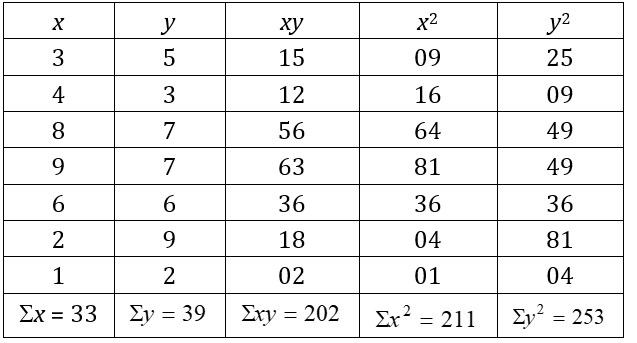Maths-
General
Easy
Question
Karl Pearson's coefficient of correlation between x and y for the following data is

- 0.480
- – 0.480
- 0.408
- – 0.408
The correct answer is: 0.408

Now, 
Þ  Þ
Þ .
.
Related Questions to study
maths-
Karl Pearson's coefficient of correlation between the heights (in inches) of teachers and students corresponding to the given data is

Karl Pearson's coefficient of correlation between the heights (in inches) of teachers and students corresponding to the given data is

maths-General
Maths-
If the mean of the numbers 27+x, 31+x, 89+x, 107+x,156+x, is 82, then the mean of 130+x, 126+x, 68+x, 50+x, 1+x is
If the mean of the numbers 27+x, 31+x, 89+x, 107+x,156+x, is 82, then the mean of 130+x, 126+x, 68+x, 50+x, 1+x is
Maths-General
Maths-
The mean of a set of observation is  . If each observation is divided by a, a¹ 0 and then is increased by 10, then the mean of the new set is
. If each observation is divided by a, a¹ 0 and then is increased by 10, then the mean of the new set is
The mean of a set of observation is  . If each observation is divided by a, a¹ 0 and then is increased by 10, then the mean of the new set is
. If each observation is divided by a, a¹ 0 and then is increased by 10, then the mean of the new set is
Maths-General
maths-
Compute the median from the following table

Compute the median from the following table

maths-General
maths-
The following data gives the distribution of height of students

The median of the distribution is[AMU 1994]</span
The following data gives the distribution of height of students

The median of the distribution is[AMU 1994]</span
maths-General
maths-
What is the standard deviation of the following series

What is the standard deviation of the following series

maths-General
chemistry-
Compound (A)  The Compound (A) is:
The Compound (A) is:
Compound (A)  The Compound (A) is:
The Compound (A) is:
chemistry-General
maths-
The order of [x y z]  is
is
The order of [x y z]  is
is
maths-General
maths-
If the matrix  is singular, then
is singular, then  =
=
If the matrix  is singular, then
is singular, then  =
=
maths-General
maths-
If the matrix  is singular, then the value of is :
is singular, then the value of is :
If the matrix  is singular, then the value of is :
is singular, then the value of is :
maths-General
maths-
Let A =  be a matrix, then(determinant of A ) × (adjoint of inverse of A)is equal to-
be a matrix, then(determinant of A ) × (adjoint of inverse of A)is equal to-
Let A =  be a matrix, then(determinant of A ) × (adjoint of inverse of A)is equal to-
be a matrix, then(determinant of A ) × (adjoint of inverse of A)is equal to-
maths-General
maths-
Let X=  , D =
, D =  and A =
and A =  . If X = A–1 D, then X is equal to
. If X = A–1 D, then X is equal to
Let X=  , D =
, D =  and A =
and A =  . If X = A–1 D, then X is equal to
. If X = A–1 D, then X is equal to
maths-General
maths-
If k .  is an orthogonal matrix, then k is equal to-
is an orthogonal matrix, then k is equal to-
If k .  is an orthogonal matrix, then k is equal to-
is an orthogonal matrix, then k is equal to-
maths-General
maths-
If A is square matrix such that A2 = A, then |A| equals-
If A is square matrix such that A2 = A, then |A| equals-
maths-General
maths-
If the matrix A =  is singular, then
is singular, then  equal to:
equal to:
If the matrix A =  is singular, then
is singular, then  equal to:
equal to:
maths-General



